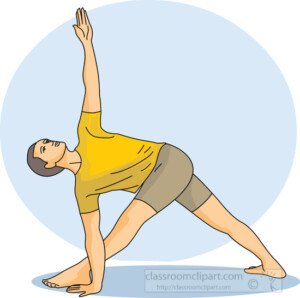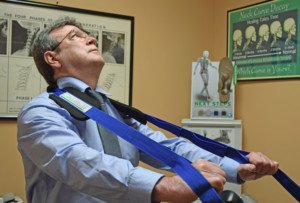
You don’t want to wait till you have spinal stenosis to wonder what kind of exercises could have possibly prevented it.
Spinal stenosis tends to be progressive. In its severe form, the patient walks or stands way stooped over.
This condition can begin in middle age, even sooner.
The time for prevention strategies is when you’re young, not old.
The time to reverse spinal stenosis, which makes a person shorter by forcing them to maintain a stooped-forward position, is before you ever begin developing this common condition.
“Spinal stenosis can be the result of several causes, such as surgery or traumatic injury,” says Dr. Tom Carpenter, corrective exercise specialist, certified personal trainer and chiropractor, inventor of Stand Corrected™, a portable harness-like stretching tool that helps alleviate back, neck and shoulder pain.
But it also seems to develop for no apparent reason in many men and women.

Spinal stenosis
“One suspected cause of spinal stenosis is a postural issue resulting in the loss of the normal forward (lordotic) curvature to the lumbar or cervical spine,” says Dr. Carpenter.
“This in turn can result in displaced discs, misaligned vertebrae and associated muscle spasms.”
The patient feels pain upon standing erect, but experiences relief when stooping forward – also known as trunk flexion.
Sometimes an annoyed person will order their spouse, who has spinal stenosis, “Stand STRAIGHT!”
Prevention is the best medicine for spinal stenosis.
Isn’t it interesting that you won’t see too many cases of spinal stenosis among the demographic who works out hard at the gym in the free weight area?
Though most gym-goers who exercise vigorously are in their 20s and 30s, there are also plenty of middle agers too.
Don’t check out the middle age people holding onto treadmills, slogging along on the elliptical trainers, moving slowly in group fitness classes, doing 200 baby crunches and doing seated rows and machine shoulder presses with only 25 pounds – for the past six months.
DO take a look at the middle age men and women who are killing it in the free weight area with impressive loads, focusing on moves like the deadlift, standing overhead barbell press, kettlebell swing, squat-to-overhead heavy-ball toss, and weighted walking lunge.
See if you can spot any who have the classic presentation of spinal stenosis: sustained trunk flexion. You’ll be hard-pressed to find anyone.
- Is this just an odd coincidence?
- Or can core exercises prevent spinal stenosis?

Though there is no known workout template that’s been scientifically proven to prevent this condition (and of course, a vehicular accident could make any exercise-prevention approach obsolete), there ARE some core involved exercises, in addition to the previously listed ones, that you can do to greatly reduce the odds of ever developing this painful, unsightly malady.
Dr. Carpenter recommends that you focus on the core stabilizers and core movers. This means recruiting both the slow and fast twitch muscle fibers that make up the core.
“These are the main posture muscles that can contribute to maintaining healthy spinal posture. And a healthy spinal posture can go a long way in warding off preventable spinal stenosis.”
The following core engaging exercise will help prevent spinal stenosis. It recruits the low back musculature like crazy.
• With bent arms, hold a weight close to your chest, then with perfectly erect posture, simply walk about.
• The weight may be a large plate resting on the underside of your forearms; a dumbbell held in each hand hammer-style (bent arms, forearms parallel to the floor); or a kettlebell held by both hands (arms bent).
• The weight, which is anterior to the spine, will pull the trunk forward – forcing engagement of the core muscles to prevent this.
• Keep walking, maintaining textbook posture, feeling those small stabilizer muscles of the low back working to prevent the weight from pulling your trunk forward.
• Do several sets with a weight that makes it very difficult to walk longer than 30 seconds.
More Core Exercises to Help Prevent Spinal Stenosis




Photo credit: Aleesia Forni


























